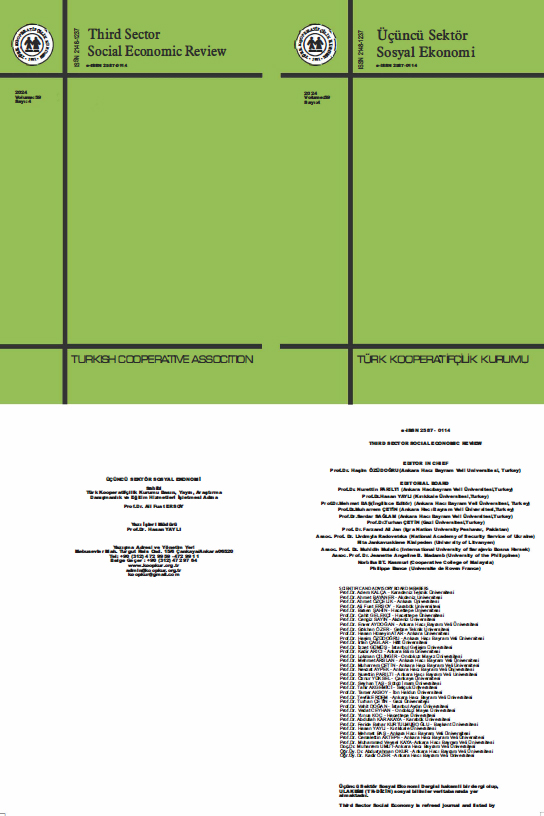Yıl: 2024 Cilt: 59 Sayı: 4 Sayfa: 2728-2746
doi: 10.15659/3.sektor-sosyal-ekonomi.24.11.2553
TÜRKİYE’DE İSTİHDAMSIZ BÜYÜME HİPOTEZİNİN ANALİZİ: FOURIER KANTİL NEDENSELLİK TESTİ̇
İDRİS YAĞMUR
İstihdam ve ekonomik büyüme değişkenleri, ülke ekonomilerinin başarı göstergeleri olarak değerlendirilmekte ve gelişmişlik düzeyine bakılmaksızın her ülkenin ekonomi politikalarının vazgeçilmez unsurlarının başında gelmektedir. Ekonomik büyüme sayesinde başka bir ifadeyle üretilen mal ve hizmet miktarındaki artışın, beraberinde bunları üretmek için kullanılan işgücünde de artış meydana getirmesi beklenmektedir. Ancak son dönemlerde uygulamada bu beklentinin tersi sonuçların ortaya çıktığı ve bazı ülkelerde ekonomik büyüme artmasına rağmen, istihdam oranlarının azaldığı görülmektedir. Bu durum, “istihdamsız büyüme” olarak adlandırılmaktadır. Ekonomik büyümenin istihdam artışı oluşturmadığı bu süreç içerisinde genellikle işsizlik oranlarında da artış yaşanmaktadır. Bu çerçevede çalışmanın amacı, 2005:Ç1-2024:Ç1 dönemini kapsayan çeyreklik verileri kullanarak Türkiye ekonomisi için istihdamsız büyüme hipotezinin geçerliliğini; büyüme oranı, istihdam oranı, erkek istihdam oranı ve kadın istihdam oranı verilerini kullanarak ayrı ayrı test etmektir. Bu amaçla çalışmanın analiz kısmında, değişkenlere yönelik ilk olarak Fourier KPSS durağanlık testi uygulanmış daha sonra ekonomik büyüme ve istihdam değişkenleri arasındaki ilişkiyi incelemek amacıyla Fourier Kantil nedensellik testi kullanılmıştır. Analiz sonuçlarına göre; büyümeden istihdama, erkek istihdamına ve kadın istihdamına doğru herhangi bir nedensellik ilişkisi tespit edilememiştir. Dolayısıyla Türkiye’de genel ve cinsiyet bazında istihdamsız büyüme hipotezinin geçerli olduğu sonucuna ulaşılmıştır.
Anahtar Kelimeler (Keywords): Ekonomik Büyüme, İstihdam, Türkiye, Fourier KPSS Durağanlık Testi, Fourier Kantil Nedensellik Testi.
ANALYSIS OF THE JOBLESS GROWTH HYPOTHESIS IN TÜRKİYE: FOURIER QUANTILE CAUSALITY TEST
Employment and economic growth variables are considered as the success indicators of national economies and are indispensable elements of the economic policies of every country, regardless of its level of development. In other words, an increase in the amount of goods and services produced through economic growth is expected to lead to an increase in the labor force used to produce them. However, it is observed that the opposite of this expectation has recently emerged in practice and that employment rates have decreased in some countries despite the increase in economic growth. This situation is called “jobless growth”. In this process in which economic growth does not generate employment growth, unemployment rates generally increase. In this framework, the aim of the study is to test the validity of the jobless growth hypothesis for the Turkish economy by using quarterly data covering the period 2005:Q1-2024:Q1 separately using growth rate, employment rate, male employment rate and female employment rate data. For this purpose, in the analysis part of the study, the Fourier KPSS stationarity test was first applied to the variables and then the Fourier Quantile causality test was used to examine the relationship between economic growth and employment variables. According to the results of the analysis, no causality relationship was found from growth to employment, male employment and female employment. Therefore, it is concluded that the jobless growth hypothesis is valid in Türkiye in general and in terms of gender.
Anahtar Kelimeler (Keywords): Economic Growth, Employment, Türkiye, Fourier KPSS Stationarity Test, Fourier Quantile Causality Test.
Tam Metin 102











